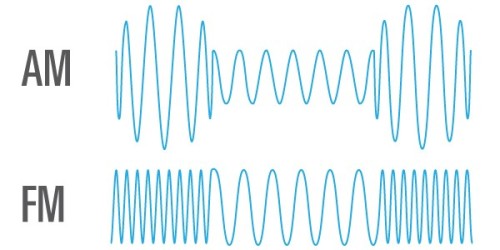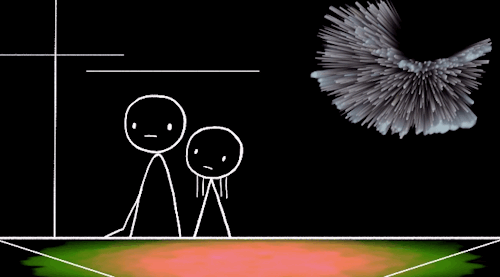Thekrishankumar - Krishan Kumar

More Posts from Thekrishankumar and Others

AM & FM: How Radio Works
Lately I’ve been thinking about how the things I use every day actually work, and since I listen to a lot of podcasts, you can guess where this post is going: radio.
In a studio, a microphone converts sound waves from a person’s voice into an electronic audio signal. If this was sent out by itself, it would only travel a few metres in air before it faded out. To get radio waves to travel long kilometres to a receiver, we have to combine it with a “carrier wave”—an electromagnetic wave.
Electromagnetic waves are made up of oscillating electric and magnetic fields, just like visible light, but radio waves are right down on the lower end of the spectrum, so their wavelengths are very long—around 300 metres.

(Image Credit: NASA)
Sound information is combined with the wave by altering or modulating the wave’s properties, like changing its amplitude, frequency, or phase. There are two ways to combine the audio signal with the carrier wave: amplitude modulation (AM) or frequency modulation (FM).
AM radio changes the overall amplitude or strength of the wave, varying its height in order to incorporate the sound information. FM radio works a little differently, because it changes the frequency of the wave rather than the amplitude. The frequency is the number of wavelengths that pass by a given point per second—physically, a high frequency wave would look squashed up, and a low frequency wave would look stretched out.

(Image Credit: Wikimedia Commons)
Both kinds of waves are susceptible to variations in amplitude as they zoom off through the air, but since FM radio relies on changes in frequency rather than amplitude, these variations don’t matter—they can just be ignored, and so the sound quality is usually super clear. But AM radio relies on the amplitude to convey information, so when the amplitude is varied a bit, this results in interference or static, which will be a familiar idea if you’ve ever listened to AM radio on a rural country road. The upside of AM radio is that it travels much further than FM radio, which is probably why you’re listening to it on that rural country road in the first place.
So once these radio waves—whether AM or FM—hit a radio receiver, their oscillating fields induce a current in the conductor. The sound information encoded into the waves can be extracted, and converted back to sound waves to grace your ears with your favourite music or talk show.
(Bonus: if you want to use science to learn more cool science, my fave podcasts are Radiolab, the Infinite Monkey Cage, and Big Picture Science.)






"Google Glass" takes on a whole new meaning with the rendering for Google’s futuristic new headquarters.

Such Beautiful Work Here!









First 3 Days in Dubai
Here is a photographic round up of my first 72 hours in the surreal city of Dubai. So far I have mostly explored the Marina and Business Bay, with a small venture out in to the new development regions of Dubailand, including Sports City and Motor City.
Over the next few days I will be exploring west towards Jebel Ali.
By Freddie Ardley Photography
Check out Freddie’s: Instagram Facebook Website






"World of Tomorrow," the new animated short by Don Hertzfeldt, promises to be one of the best sci-fi movies in years — if the first trailer is any indication.

vegnews: Vegan Swedish meatballs at IKEA, come to mama!!! Story here.
Amazing!!!








In just over a week I will be embarking on my most ambitious project since visiting Mount Everest and the fabled Himalayas. Until March I will be exploring the mountains, deserts, seas and cities of the United Arab Emirates.
It will be a return to photographing the globe and a focus on the geography and culture that resides on the shores of the Persian Gulf. I will be regularly blogging about the country and at the end will have select pieces going into a very exciting exhibition in London that I am apart of.
Stay tuned for all the Arabian peninsula has to offer, I can’t wait to be back in a desert!
Freddie Ardley Photography
Check out Freddie’s: Instagram Facebook Website
-
 iseekiss reblogged this · 1 year ago
iseekiss reblogged this · 1 year ago -
 nennolam-blog reblogged this · 6 years ago
nennolam-blog reblogged this · 6 years ago -
 angryhumanoidgoopegg-blog reblogged this · 6 years ago
angryhumanoidgoopegg-blog reblogged this · 6 years ago -
 spacesball reblogged this · 7 years ago
spacesball reblogged this · 7 years ago -
 darkdominantviking liked this · 8 years ago
darkdominantviking liked this · 8 years ago -
 pajros liked this · 8 years ago
pajros liked this · 8 years ago -
 itz-mvckey reblogged this · 8 years ago
itz-mvckey reblogged this · 8 years ago -
 misterjppp liked this · 8 years ago
misterjppp liked this · 8 years ago -
 jackguar liked this · 8 years ago
jackguar liked this · 8 years ago -
 itz-mvckey reblogged this · 8 years ago
itz-mvckey reblogged this · 8 years ago -
 xmarksthesp0t liked this · 8 years ago
xmarksthesp0t liked this · 8 years ago -
 blueberriesbloom reblogged this · 8 years ago
blueberriesbloom reblogged this · 8 years ago -
 blueberriesbloom liked this · 8 years ago
blueberriesbloom liked this · 8 years ago -
 realizedude reblogged this · 8 years ago
realizedude reblogged this · 8 years ago -
 meeka-chu liked this · 8 years ago
meeka-chu liked this · 8 years ago -
 calijackie09 liked this · 8 years ago
calijackie09 liked this · 8 years ago -
 aureus-corvus reblogged this · 8 years ago
aureus-corvus reblogged this · 8 years ago -
 aureus-corvus liked this · 8 years ago
aureus-corvus liked this · 8 years ago -
 mfarawr reblogged this · 8 years ago
mfarawr reblogged this · 8 years ago -
 tragic-lamppost reblogged this · 8 years ago
tragic-lamppost reblogged this · 8 years ago -
 hipstirrednotshaken liked this · 8 years ago
hipstirrednotshaken liked this · 8 years ago -
 jeymsss reblogged this · 8 years ago
jeymsss reblogged this · 8 years ago -
 jeymsss liked this · 8 years ago
jeymsss liked this · 8 years ago -
 four1nine reblogged this · 8 years ago
four1nine reblogged this · 8 years ago -
 violin-concerto liked this · 9 years ago
violin-concerto liked this · 9 years ago -
 mariusvdb-blog liked this · 9 years ago
mariusvdb-blog liked this · 9 years ago -
 everythingelse-was-taken-blog reblogged this · 9 years ago
everythingelse-was-taken-blog reblogged this · 9 years ago -
 everythingelse-was-taken-blog liked this · 9 years ago
everythingelse-was-taken-blog liked this · 9 years ago -
 broken-byrd liked this · 9 years ago
broken-byrd liked this · 9 years ago -
 negativesquare liked this · 9 years ago
negativesquare liked this · 9 years ago -
 and-not-a-bit-wise reblogged this · 9 years ago
and-not-a-bit-wise reblogged this · 9 years ago -
 and-not-a-bit-wise liked this · 9 years ago
and-not-a-bit-wise liked this · 9 years ago -
 xsweettreatx reblogged this · 9 years ago
xsweettreatx reblogged this · 9 years ago -
 yourinsidesxrayed liked this · 9 years ago
yourinsidesxrayed liked this · 9 years ago -
 breathingorsleeping-blog reblogged this · 9 years ago
breathingorsleeping-blog reblogged this · 9 years ago -
 gerardssweetface reblogged this · 9 years ago
gerardssweetface reblogged this · 9 years ago
16, I love Technology & Science Stuff . krishan@krishankumar.me
82 posts